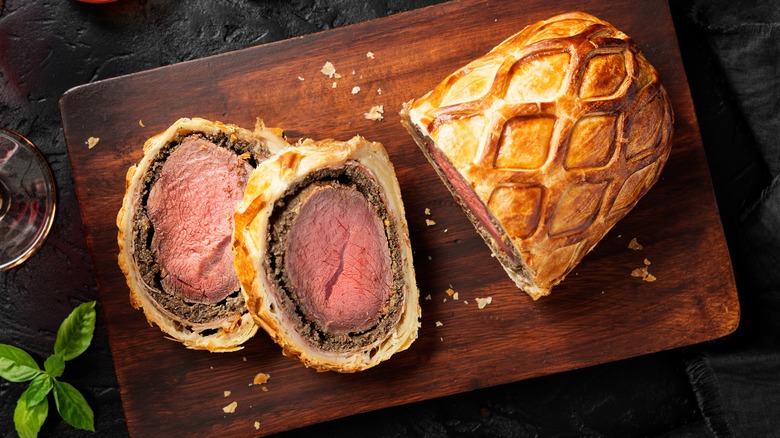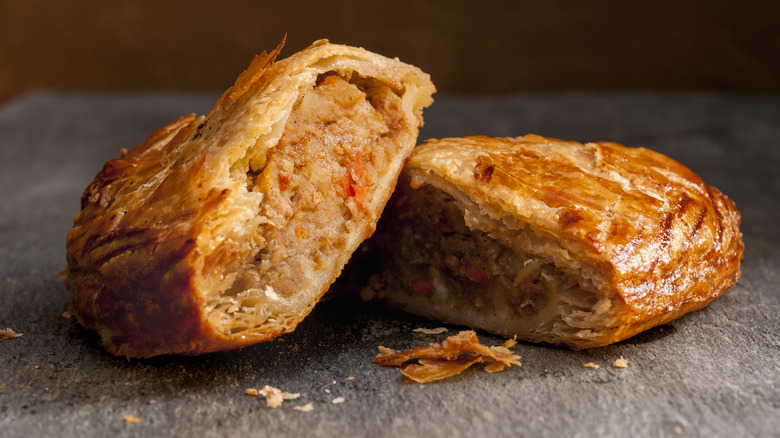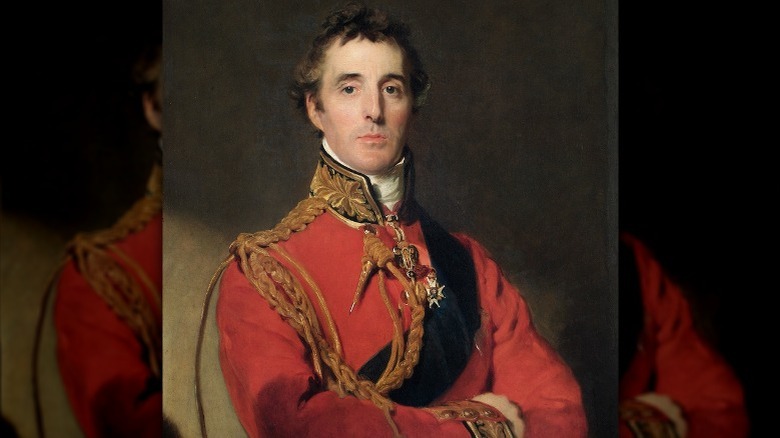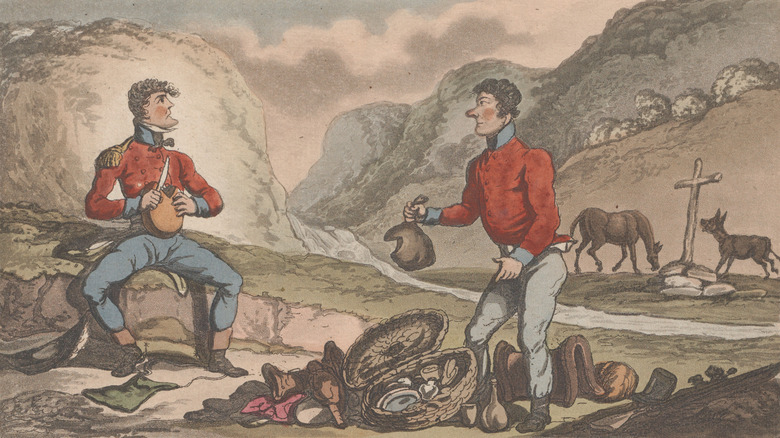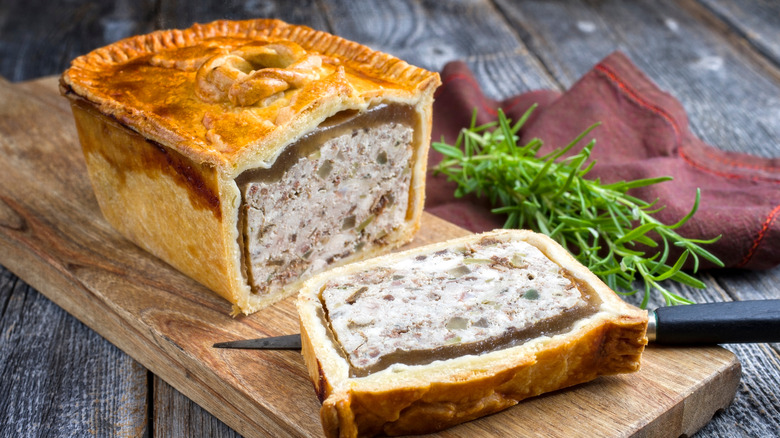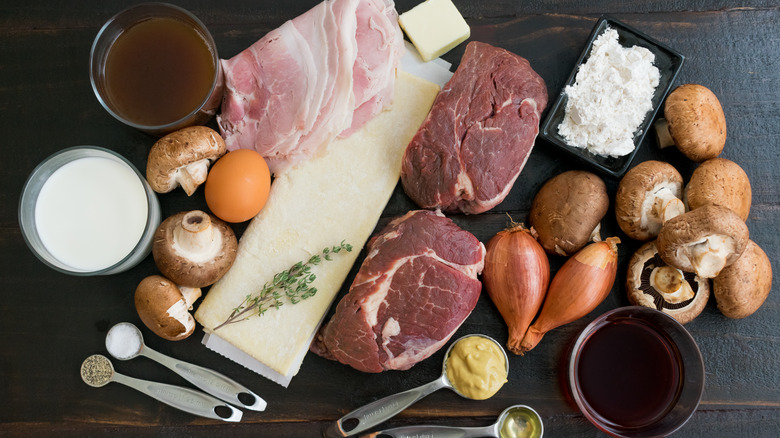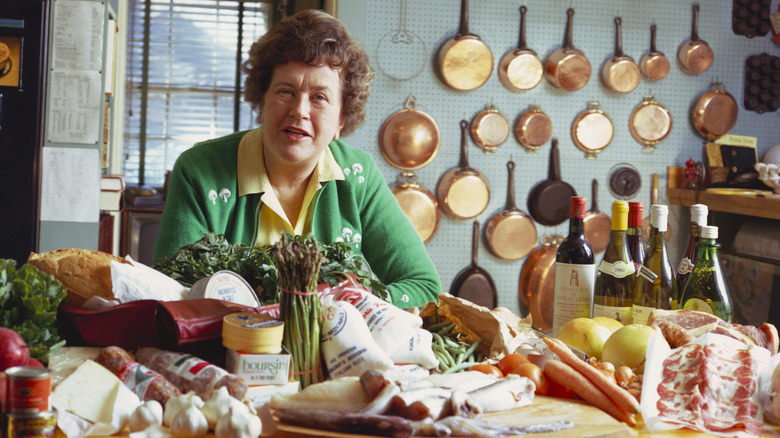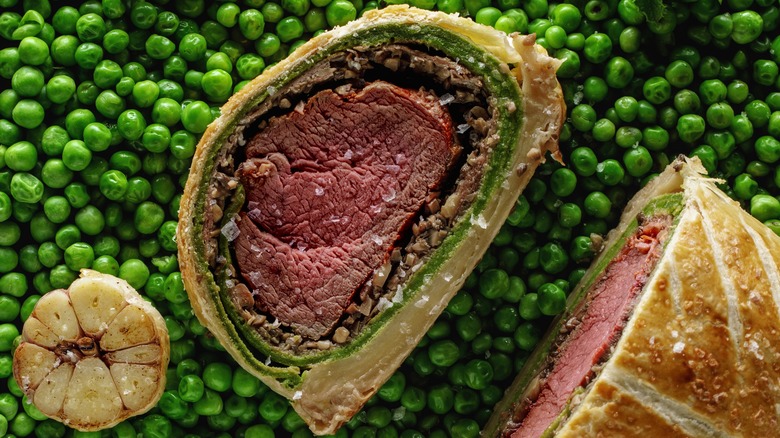The History Of Beef Wellington
Widely regarded as a traditional British food, Beef Wellington's true history remains a mystery, and there are many contradictory myths about its origins. A dish with hypothetical French ties given a British name after an Irish military commander but made popular in America, numerous legends suggest that this sumptuous fare has an international story.
A culinary tour de force, any proper Beef Wellington comprises a trinity of luxury ingredients. Tenderloin steak, a prime cut of beef, gets bathed in a layer of pâté and duxelles (finely diced mushrooms sautéed in butter) before the whole thing is enveloped in a pastry crust and cooked. Considering some of these luxuries are archetypal French ingredients, it's not unrealistic to suspect that the dish might have first been eaten across the Channel, even if it has since come to be regarded as thoroughly British fare. In any case, both France and Britain have a longstanding culinary tradition of pastry-encased meat dishes that gives them both a historic claim to forbears if not Beef Wellington itself.
The mystery regarding Beef Wellington's origins lies, rather, in the lack of evidence to corroborate either nation's claim to it. The earliest evidence comes instead from American recipes, restaurants, cookbooks, and cooking shows, suggesting that all the transatlantic origin tales of this savory coup de maître may have simply been a means of adding a little more spice to the Beef Wellington itself.
It follows an ancient tradition
The concept of meat-filled pastry dates back to the ancient Greeks, who cooked meat in a primitive pastry shell made from a simple combination of flour and water. The Romans followed suit with their own concoctions, filling pastry with various meats and fish. Pastry-wrapped meat created a portable meal and protein source, the pastry turning into a sort of edible lunchbox that further served to preserve the meat inside (but was not necessarily intended to be eaten).
Pastry-wrapped meat was historically popular among soldiers and sailors, who were away from home for long periods without easy access to fresh meals. Not only could conserved meat be eaten on the march, it would also keep for weeks, providing unprecedented access to cooked meat as a daily staple.
Meat-filled pastry gained its popularity in the U.K. in the 13th century with the innovation of mince pies. These were made from a crust meant to be eaten, and the meat within was seasoned with winter spices that contributed to the pies' Christmas and Yuletide associations. A more quotidian version of a pastry-wrapped meal arose in the form of the Cornish pasty. A working-class all-in-one meal to go, the Cornish pasty is a half-circle pastry more commonly filled with vegetables but occasionally some meat. It has Cornish associations because it became the go-to meal for miners working long shifts in Cornwall's mine-based economy.
It is named for the First Duke of Wellington
No matter where the dish came from, when it was created, or who ate it first, Beef Wellington acquired its name as an homage to Arthur Wellesley, the First Duke of Wellington, who, after great military success, eventually became Britain's prime minister. Perhaps most renowned for his defeat of Napoleon at the Battle of Waterloo in 1815, the Duke of Wellington quite possibly became the namesake for Beef Wellington as a means of honoring his victory.
A few theories exist as for how Beef Wellington may have come to have associations with this one particular military figure, but they remain unproven. One myth suggests that the dish was named after Wellington because it was his favorite meal, implying that it existed before 1815. Though there is no easily accessible evidence for when the dish was first prepared, Steig Wellington, the Irish name for Beef Wellington, is included among Ireland's traditional dishes, and Wellington himself was of Irish origins. But other stories state that Beef Wellington may instead have been invented simply for Wellington's Waterloo success and thus named in his honor.
Another tale suggests that Beef Wellington was named after the commander more indirectly, because the shape of the pastry-wrapped meat mound vaguely resembles the Wellington boot. This was a waterproof boot with origins as a military invention that the Duke of Wellington popularized, and which would later evolve into the Wellies that are commonplace today.
It could have been a form of military takeout
Despite being named for a particular dish that has more modern associations with fine dining, the Duke of Wellington was ironically not known for being a gourmand. Even though Wellington was a man of great renown, his palate was never as refined as his military tactics. As lore states, he didn't particularly care what his military chef prepared and this gave the chef, a known innovator, the go-ahead to cook up whatever he wanted.
According to another theory, Beef Wellington could have been devised for reasons more practical than elaborate. Some credit Wellington's chef with having invented the dish as a convenience meal for British troops. If Wellington's chef did, in fact, invent this phenomenon, it wasn't entirely all that innovative, as beef had already been covered in pastry for centuries as a means of food preservation. In an era during which modern refrigeration hadn't been invented, and following the precedent of soldiers past, meat-filled pastry remained a very convenient power meal for military marches, as it was a dense source of protein and energy that could be eaten on the go.
However, it doesn't seem likely that the British military had the resources to feed the average marching soldier on prime tenderloin beef and rich pâté. Perhaps a simpler archetype was used to feed British troops — the Beef Wellington known and loved today is, after all, a luxury dish.
The true origins are most probably French
The most probable origins for Beef Wellington, though it may be regarded as a quintessentially British dish, are in fact more likely French. There is a virtually identical French dish which quite possibly predates its British counterpart and is known as filet de boeuf en croûte. Though origins for this French dish are equally vague, filet de boeuf en croûte is a rendition of another French phenomenon wrapped in pastry crust, the pâté en croûte. Though not made from steak filet, the dish consists of various ground meats encased in a puff pastry loaf, and dates back to the Middle Ages.
Even if a link between French recipes and Beef Wellington is not definitive, the similar ingredients and cooking methodology can't be denied. But whether or not filet de boeuf en croûte and Beef Wellington were one and the same remains a mystery. Among the numerous myths surrounding Beef Wellington's inextricable (and inexplicable) connection to the Duke of Wellington's influence is one notion that might be more likely than the rest: The French dish, whether or not it was a favorite of the Duke's, was renamed after him as a defiant means of rebranding. The dish's name would be a symbolic final blow — after the Battle of Waterloo it was henceforth known as Beef Wellington to further emphasize Wellington's British victory over the French.
A recipe was first published in the United States
If Beef Wellington's origins are either British or French, there remains a suspicious lack of recorded evidence for either empire's claims to the dish's invention. Though the Waterloo legends would suggest that Beef Wellington was served at least from 1815 onward, the dish does not make an appearance in 19th-century cookbooks or cooking guides, French or British. "I have never been able to find a reference to Beef Wellington in any British cookery book, old or new," Jane Garmey writes to preface her Beef Wellington recipe in her 1981 cookbook "Great British Cooking: A Well Kept Secret." But she emphasizes, at least, that in the U.K., "cooking meat in a pastry case was fairly common at the end of the eighteenth century."
A dish with the official title of Wellington hasn't been found in a source that predates 1903, and rather than being published across the pond, this recipe is actually American. Making its grand appearance in a Chicago newspaper as "Beef à la Wellington," it disappeared again from public record until it resurfaced again in a New York paper in 1939. The lack of evidence surrounding Beef Wellington's Anglo-Franco provenance could suggest another story entirely — that enterprising publishers devised an elaborate origin tale for what was then a novel luxury dish in order to garnish it with greater prestige.
An American chef made Beef Wellington mainstream
Though myths claim the dish's origins began across the pond, it was American public figures who brought Beef Wellington into mainstream public consciousness. American chef and TV personality Julia Child popularized French food in midcentury America with her book "Mastering the Art of French Cooking." The book, first published in 1961, was soon followed by a TV series, "The French Chef," in which Child demonstrated the recipes in her cookbook step by step. In 1965, she hosted an episode that highlighted the recipe "Filet of Beef Wellington." "Every once in a while ... you want to do a bang-up fancy dinner and have a wonderful main course," she says in the episode's introduction, later describing the Filet of Beef Wellington as something that's going to "come out looking like a ship of state."
But Child's episode creates further confusion regarding the dish's provenance, as the name "Filet of Beef Wellington" suggests a fundamental British influence, even though it was introduced in French cooking show. Child doesn't discuss the dish's origins, and with no context, her recipe seems to have come from out of nowhere. But with tenderloin beef — an expensive cut — swathed in duxelles and foie gras before getting baked in a pastry crust, Child's nationally broadcasted Beef Wellington recipe became the epitome of sophisticated eating. The dish sparked a chic, complex, fine-dining trend in the 1960s that would persist for a few decades.
By the late 20th century, the dish was a chic classic
Julia Child's Beef Wellington recipe became the catalyst for an entire Wellington era across the United States. Through the 1980s, Beef Wellington was the pièce de résistance of dinner parties throughout America, turning the dish into a competitive main course for the most ambitious home chefs. Adding to the craze, President Richard M. Nixon went on to claim Beef Wellington as his favorite meal. (President John F. Kennedy was fond of it as well, albeit before Child's episode aired.) Nixon allegedly requested the dish for as many state dinners as possible, further enhancing Beef Wellington's prestige and popularity throughout the country.
How the dish went from American food fad to British icon is as mysterious as the dish's origins, but at the same point as the American Wellington craze, the dish reached enough acclaim in the U.K. to be considered British enough for Jane Garney's 1981 cookbook "Great British Cooking: A Well Kept Secret." Despite a lack of proof regarding beef Wellington's true validity among her recipes, she affirmed that "it would seem unfair to omit Beef Wellington for its dubious heritage."
Perhaps losing some of its prestige due to the slew of modern kitchen hacks (like canned liver paste and premade pastry dough) that made Beef Wellington a much simpler dish to prepare, the recipe wasn't such a novelty in America after the '80s. The greater longevity of its popularity in the U.K. may be what has solidified the dish's perception as quintessentially British.
Beef Wellington is having another moment
In recent years, Beef Wellington has been making a comeback as one of the most popular ways steak is enjoyed around the world. It is perhaps well-suited to modern palates because it is equal parts gourmet and comfort food. A number of chefs have introduced Wellington spinoffs incorporating every kind of meat imaginable. A few vegetarian takes, like a version filled with butternut squash, have introduced a whole new dimension to the Wellington's possibilities.
The dish in its more traditional form owes a great deal of its renewed popularity to British celebrity chef Gordon Ramsay. "When I started doing the research, I found that a lot of chefs in the UK had forgotten about the Wellington because it seemed dated," he told Washingtonian in 2022, emphasizing, "Now, of course, every chef on the planet is doing their version." Beef Wellington is among Ramsay's favorite dishes of all time, a meal he has declared, according to his restaurants' website, "would definitely be on my Last Supper menu."
